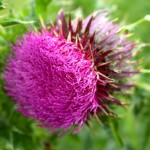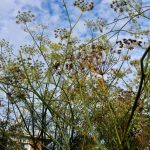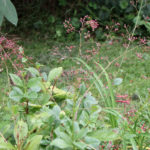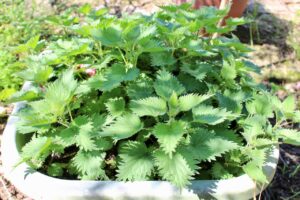
Perennial Stinging nettle (Urtical dioica) in a pot
With spring in the air nature is waking up. I love seeing dormant plants emerging with fresh new growth. My patch of stinging nettle is in a large square pot so it can’t spread. If it is not respected and brushed lightly it will cause itchy, irritated skin. ‘Urtica’ comes from latin meaning to burn. An antidote usually grows nearby such as dock or plantain – rub the leaves on the affected area. But if you grasp nettle firmly as the saying goes, the hypodermic nettle needles cannot impart their histamine. Such protection is a sign that the plant is rich and nutritious. Red admiral butterfly caterpillars who eat the leaves in summer know this.
Many other people around the world know this too and avidly wait for it in spring, when it’s a good time to do an internal spring clean. There are two common varieties:
Urtica urens – annual stinging nettle or dwarf nettle is common in gardens, under trees and waste places, preferring light soils growing up to 60cm tall on a single stem that can branch out, and has short stinging bristles on the stems and serrated leaves. It has clusters of tiny flowers where the leaf meets the stem. I’ve been using this nettle all winter, as a plant grew in the greenhouse and produced a lot of leaves.
Urtica dioica – Perennial nettle has rhizomes that form dense patches originally from Europe, they now grow all over the world up to 1.5m tall.
Nettle can be cut down regularly and soaked it for 7-21 days to make a nutritious liquid plant food – it is said to be an insect repellent and a good foliar feed for plants.
I can assure you the sting becomes harmless when the leaves are dried, cooked or blended and are great in quiches, frittatas and soup (recipe below) as well as smoothies and it makes a nice cup of warming, nourishing tea. Use like spinach or silver beet.
Nettles are highly valued by herbalists for their healing properties and are powerful blood cleansing and blood building plants. They are rich in iron being beneficial for anaemia, and other blood disorders as well as boosting energy levels. Nettle is a diuretic (reducing excess water in e body) and an excellent hair tonic, boil some leaves and once cooled rinse your hair with the strained liquid. Drinking nettle regularly diminishes the susceptibility to colds and restores digestion at the same time it deeply nourishes, due to so much nutrition. Nettle is an excellent source of calcium, magnesium and chlorophyll, high in chromium, cobalt, iron, phosphorus, potassium, zinc, copper and sulphur as well as protein, B Vitamins, and Vitamins C, K and A. Nettle tea helps lessen allergies and menopausal problems. In addition, it is a powerful preventative of rheumatism.
My Dad had nettle soup during the war in England and when I made it he instantly recognised what it was.
Nettle Soup
4 large handfuls of nettle tops (use gloves and ‘grasp the nettle’)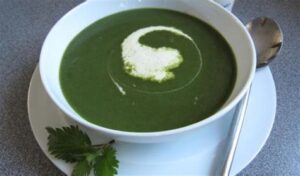
1 large onion
50 gm butter or coconut oil
2 potatoes
1 litre of vegetable stock
1 tbs crème fraîsche or yoghurt
Seasoning including grated nutmeg
Strip the nettles from the thicker stalks and wash
Melt the butter and simmer chopped onion until translucent
Add the nettles and chopped potatoes and cook for 2-3 minutes
Add the stock and simmer for 20 minutes, using a wooden spoon now and then to crush the potatoes
Add the seasoning with a little grated nutmeg and a swirl of crème fraîsche or yoghurt
If you prefer a smoother soup, liquidise before serving.
Reheat, add the other seasonings and serve.
from “Food for Fre
